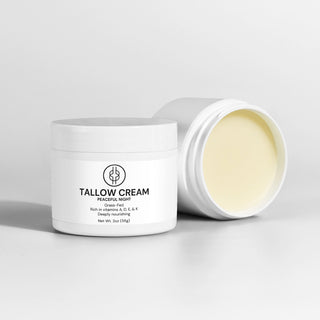Deep Moisturization and Skin Barrier Support
Grass-fed tallow is abundant in triglycerides, including oleic, palmitic, stearic, and linoleic acids, which are integral to maintaining skin hydration and integrity. These fatty acids reinforce the skin's lipid barrier, effectively locking in moisture and preventing transepidermal water loss. This deep moisturization leads to a supple and rejuvenated complexion.
Fatty acids are fundamental components of our skin's structure and function, playing pivotal roles in maintaining its health and integrity. Among these, triglycerides such as oleic, palmitic, stearic, and linoleic acids are particularly significant. Understanding their individual contributions provides insight into how they collectively support skin health.
Oleic Acid (Omega-9 Monounsaturated Fatty Acid)
Oleic acid is a monounsaturated fatty acid prevalent in various natural oils. It possesses the unique ability to penetrate deeply into the skin, enhancing the absorption of other beneficial compounds. This deep penetration aids in delivering nutrients to the lower layers of the epidermis, promoting overall skin nourishment. However, it's noteworthy that excessive application of oleic acid can disrupt the skin barrier, potentially leading to dermatitis with continuous use.
Palmitic Acid (Saturated Fatty Acid)
Palmitic acid is a saturated fatty acid naturally present in the stratum corneum, the outermost layer of the skin. It plays a crucial role in forming a protective barrier on the skin's surface, shielding it from environmental pollutants and reducing transepidermal water loss. This barrier function helps maintain skin hydration and prevents dryness.
Stearic Acid (Saturated Fatty Acid)
Stearic acid, another saturated fatty acid, works synergistically with palmitic acid to reinforce the skin's protective barrier. It contributes to the skin's flexibility and suppleness by supporting the lipid matrix of the stratum corneum. This reinforcement is vital for maintaining the skin's structural integrity and resilience against physical stressors.
Linoleic Acid (Omega-6 Polyunsaturated Fatty Acid)
Linoleic acid is an essential polyunsaturated fatty acid that the human body cannot synthesize, necessitating its acquisition through diet or topical application. It is a critical component of ceramides, lipid molecules that maintain the skin's barrier function and hydration. A deficiency in linoleic acid can lead to a compromised skin barrier, resulting in dryness, scaliness, and increased water loss. Moreover, adequate levels of linoleic acid have been associated with reduced acne severity, as it helps prevent the formation of microcomedones.
Collective Impact on Skin Health
The harmonious presence of these fatty acids ensures the skin remains hydrated, supple, and resilient. They collectively contribute to:
-
Barrier Function: Palmitic and stearic acids fortify the skin's barrier, protecting against environmental aggressors and preventing moisture loss.
-
Moisturization: Oleic acid facilitates deep hydration by enhancing the penetration of moisturizing agents.
-
Anti-Inflammatory Effects: Linoleic acid exhibits anti-inflammatory properties, soothing irritated skin and supporting conditions like acne.
-
Structural Integrity: Stearic acid supports the skin's structural framework, maintaining its firmness and elasticity.
Incorporating these fatty acids through topical applications, such as creams rich in grass-fed beef tallow, can provide the skin with these essential nutrients, promoting overall skin health and vitality.
Anti-Inflammatory Properties
The presence of conjugated linoleic acid (CLA) in grass-fed tallow contributes to its anti-inflammatory effects. CLA has been shown to combat oxidative stress and reduce inflammation, which can help in managing conditions like acne, eczema, and psoriasis.
Nutrient-Rich Composition
Grass-fed tallow is a natural source of fat-soluble vitamins A, D, E, and K:
-
Vitamin A: Supports skin cell regeneration and repair, promoting a healthy complexion.
-
Vitamin D: Assists in skin repair and metabolism, contributing to overall skin health.
-
Vitamin E: Acts as a potent antioxidant, protecting the skin from environmental damage and supporting healing processes.
-
Vitamin K: Plays a role in skin healing and may improve skin elasticity.
These vitamins work synergistically to nourish the skin, enhance its resilience, and maintain a youthful appearance.
Biocompatibility with Human Skin
One of the remarkable aspects of grass-fed tallow is its similarity to human sebum, the skin's natural oil. This likeness allows for easy absorption without clogging pores, making it suitable for various skin types, including sensitive and acne-prone skin. Its composition aligns with the skin's fatty acid profile, promoting harmony and reducing the likelihood of irritation.
Historical and Modern Perspectives
Historically, tallow has been utilized in skincare for its emollient properties. In contemporary times, there is a growing interest in natural and sustainable skincare solutions, leading to a revival of tallow-based products. However, it's essential to approach this trend with informed caution. While many users report positive outcomes, dermatologists advise considering individual skin types and potential comedogenicity. Consulting with a skincare professional before incorporating tallow into your routine is advisable, especially for those with oily or acne-prone skin.
Incorporating Tallow into Your Skincare Routine
When selecting tallow-based products, opt for those sourced from grass-fed, pasture-raised cattle to ensure a higher nutrient profile and ethical farming practices. Products like our Grass-Fed Beef Tallow Cream combine tallow with other nourishing ingredients, such as organic extra virgin olive oil and organic golden jojoba oil, to enhance the moisturizing experience. To use, apply a small amount to clean skin, massaging gently until absorbed. This practice can be particularly beneficial for dry areas, providing lasting hydration and comfort.
Conclusion
Grass-fed beef tallow stands as a testament to the efficacy of natural ingredients in skincare. Its rich composition of fatty acids and vitamins offers profound moisturization, anti-inflammatory benefits, and compatibility with our skin's biology. As with any skincare product, individual experiences may vary, so it's prudent to conduct a patch test or consult with a dermatologist before fully integrating tallow into your regimen. By embracing such traditional ingredients thoughtfully, we can align our skincare practices with nature's wisdom, achieving healthy and radiant skin.



